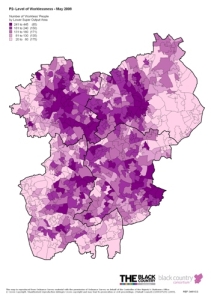
Weaknesses in the structure of the West Midlands economy mean that it was hit particularly hard by the recent recession and is likely to see further job losses over the next five years.
Our latest briefing paper (pdf, 408kb), produced as part of our West Midlands Skills Assessment 2010, reveals that the West Midlands has a weaker private sector than other parts of the country. The West Midlands has poorer representation of higher value added activities and high growth firms with the potential to create new, skilled jobs.
As a result the West Midlands has seen its share of jobs in the public sector rise more rapidly than anywhere else in the country. It is particularly vulnerable to job losses from the spending cuts announced by the government.
We forecast that West Midlands Gross Value Added (GVA) will grow by only 8% (£8.8 billion) between 2010 and 2015 and there will be a net fall in employment of more than 38,000 people.
Filed under: Birmingham, Black Country, Coventry, Data, Dudley, Economy & Labour Force, Employment, Enterprise, Innovation, Population & Society, Research, Sandwell, Skills, Solihull, State of the Region, Walsall, Warwickshire, West Midlands, West Midlands Regional Observatory, Wolverhampton, Worcestershire | Tagged: jobs, labour market, local enterprise partnerships, private sector jobs, skills assessment, West Midlands | Leave a comment »


 Inward investment is usually spread reasonably evenly between the West Midlands metropolitan areas and the shire counties. In 2009/10 the shire counties attracted the majority of inward investment projects (55%). See left.
Inward investment is usually spread reasonably evenly between the West Midlands metropolitan areas and the shire counties. In 2009/10 the shire counties attracted the majority of inward investment projects (55%). See left.

 This guest post was contributed by Christopher Styche from the
This guest post was contributed by Christopher Styche from the  The government is making £3 million available to help areas hardest hit by the recession find creative ways to reduce the negative impact empty shops are having on the high street.
The government is making £3 million available to help areas hardest hit by the recession find creative ways to reduce the negative impact empty shops are having on the high street.
 The
The  The
The  The West Midlands is the first English region to produce a
The West Midlands is the first English region to produce a 

